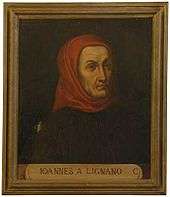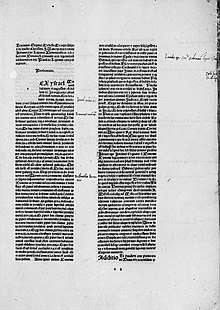John of Legnano
John of Legnano (Italian: Giovanni da Legnano; c. 1320 – February 1383) was an Italian jurist, a canon lawyer at the University of Bologna and the most prominent defender of Pope Urban VI at the outbreak of the Western Schism.

Biography
John was born in Legnano.
He was a doctor utriusque iuris, in both civil and canon law, teaching at Bologna by 1351. "According to tradition, he was schooled at the University of Bologna in liberal arts, astrology,[1] philosophy and medicine before taking his degrees in law", John P. McCall reports, suggesting that some of his backing at Bologna may have come from the Visconti of Milan, who extended their control to the south in 1350.[2] Soon he became the loyal friend of two popes in succession — Urban V, from whom he received grants and gifts, and Gregory XI, for whom he drew up the deed of purchase for the Pontifical Gregorian University — and the most prominent defender of a third, the irascible and embattled Urban VI. Urban had multiple copies of John's defense of his election, De fletu ecclesiæ distributed in the opening maneuvers of the Western Schism, including one sent to the University of Paris, and he offered him the cardinal's hat, which John cautiously refused, being married, for one thing.

His works include De Bello, a work on war and duelling prefaced by an astrological-political allegory and dedicated to Cardinal Albornoz, papal legate who took control of Bologna in 1360, often cited as an early source in international law;[3] De Pace (1364) on the virtues and vices and De pluritalite beneficiorum (1365),[4] both works dedicated to Urban V; for Gregory XI he prepared his Somnium (1372) on civil and canon law,[5] in which he revealed himself as a compiler and synthesizerand De Iuribus ecclesiæ in civitatem Bononiæ (1376), surveying the law of Bologna, among others; a Commentaria in Decretales commentary on the Decretals; and De adventu Christi (1375). He is alluded to in Chaucer’s Canterbury Tales.[6]
He died at the height of his fame. In his will he provided an endowment for poor students from Milan at the University of Bologna and bequeathed his house to the University if his male heirs should die out.[7] His pupil Cosimo de' Migliorati was elected pope as Innocent VII.
Notes
- In addition to his treatise De cometa exploring the meaning of comets, astrological discourse surfaces in several of his works (John P. McCall, "Chaucer and John of Legnano" Speculum 40.3 [July 1965:484-489].)
- McCall 1965:484-489).
- John was elected to the governorship of Bologna himself, after a local revolt against the legate in 1376, was followed by his effective conciliatory embassy to Gregory XI on the part of Bologna and its citizens.
- "On the plurality of benefices", a conventional subject of abuses in calls for reforms.
- G.W. Coopland, "An unpublished work of John of Legnano: The 'Somnium' of 1372", Nuovi studi medievali 2.1 (1925-26:65-88.
- Prologue to the Clerk's Tale, helping with the dating.Geoffrey Chaucer: Canterbury Tales, "Clerk's Tale" Archived 2006-12-07 at the Wayback Machine
- McCall 1965: 486.
References
- E. Giannazza and G. D'Ilario (Legnano, 1983), Vita opere di Giovanni da Legnano
- Thomas Erskine Holland, editor (1917), John of Legnano , Tractatus de bello, de represaliis et de duello
- Discussing his connection with Christine de Pizan and the defeat of King Richard III at Bosworth